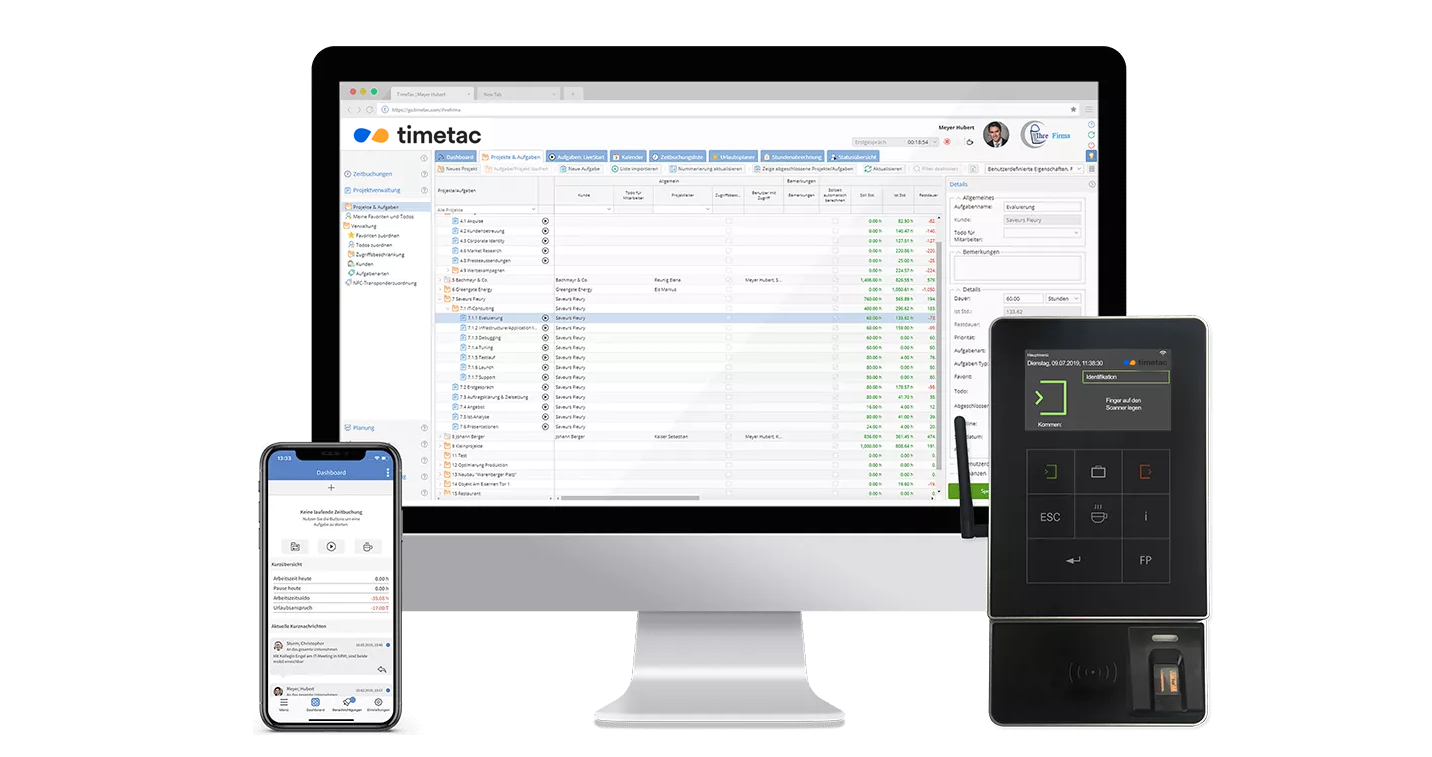Winning your team over: 3 science-backed tips for time tracking motivation
by Tanja Pichlbauer, 29.11.2023
Would you like to implement a time and attendance system, but have concerns about your employees' reactions? To ensure the success of this solution in your company, it is crucial to convince your employees. This article presents three scientifically proven tips to motivate your teams to embrace time tracking.

Get to know the two types of motivation
To ensure that you can optimally support your employees, knowing about the two basic types of motivation is helpful. Managers often focus more on extrinsic motivation, which is generated by external influences, e.g. through the awarding of bonuses and performance increases. However, intrinsic motivation, which arises from people’s desires, is the most important type of motivation for employees’ well-being, attitudes, and behaviour. [1]
It can sometimes be a challenge to motivate employees intrinsically. However, self-determination theory (SDT) can help you, as it states that the fulfilment of three psychological needs influences work motivation: need for competence, autonomy, and relatedness. [2]
I have crafted this idea into valuable tips to help you inspire your team members to monitor their working hours diligently.
1. Make all the benefits of time tracking visible.
Openness is crucial! Communicate to your team why time tracking is necessary for the company and consistently positive for the team. Most people are more motivated when they feel that they are doing something for a valid and clear reason.
As a manager, you can encourage commitment by involving everyone as soon as possible. To that end, you should point out the advantages of digital time tracking. This approach works well if you make the change personal and practical. [3]
Demonstrate transparently what the recorded times are used for to convey the value of time tracking. Examples of this would be:
- Please ensure that it is understood that there is a direct correlation between the recorded time and the subsequent payment of wages and invoices. Accurate time tracking can contribute to fair remuneration according to the hours worked. Time tracking also makes payroll accounting easier!
- Demonstrate that time recording can be used to transparently manage sensitive issues such as overtime, extra hours and holiday entitlements. It makes it easier for companies to manage accruals, for example, and shows employees how much holiday they can still use this year or whether they can still reduce their overtime.
- Explain to your team what you will do with the data you gather. You could create reports, for example, to make transparent how much effort is going into a specific project or to track its progress
- Work time tracking might be required by law.
2. Show your employees how the new time tracking system works
You need to understand something to use it properly and willingly. In addition to the importance of time tracking, your teams naturally need to know and learn how the new time and attendance system works. Good training is important; support your employees as they take their first steps. In this way, you encourage them to develop their time management skills. This, in turn, will awaken intrinsic motivation. Stronger intrinsic and internalised motivations are associated with more positive results. [4]
- Choose an intuitive time-tracking system. It is best to test it, even in a team, before deciding.
- Make the most of the provider’s training, such as attending a complimentary webinar.
- Provide precise specifications and framework conditions to ensure that projects and tasks are recorded as intended.
3. Streamline time tracking and ensure its ease and practicality for your employees
A contemporary time and attendance system like TimeTac enables recording working hours anytime and anywhere, irrespective of whether your employees are in the office, working remotely, or travelling. It is not only straightforward but also highly practical, providing much freedom and flexibility. Most importantly: it promotes the autonomy of your employees! [5]
When a person acts autonomously, they can feel more independent and participate in an activity voluntarily and consciously. They can control their actions and utilise their resources efficiently.
The degree of autonomy in people is strongly related to how motivated they are. This motivation can change depending on their social environment. People react differently based on whether they do things voluntarily or feel forced to do them.
As a team leader, you can strengthen the autonomy of your employees by offering choices. A few examples:
- Enable different working time models
- Flexible organise core and flexitime
- Take breaks and track them as you need them
- Manage time and tasks (to-dos) independently by tracking
Remember that implementing new solutions takes time. Be patient and support your teams in adapting to the new way of work. We also recommend obtaining feedback regularly and adjusting your approach if necessary. If you seek additional tips and tricks on time tracking, please visit our blog. We hope you achieve great success with launching your time-tracking system!

Time tracking, trust and autonomy
Discover the advantages first-hand.
Sources:
[1] Van Den Broeck, A., Howard, J. L., Van Vaerenbergh, Y., Leroy, H., & Gagné, M. (2021). Beyond Intrinsic and Extrinsic Motivation: A meta-analysis on Self-determination theory’s multidimensional conceptualization of work motivation. Organizational Psychology Review, 11(3), 240–273. https://doi.org/10.1177/20413866211006173
[2] Ryan, R. M., & Deci, E. L. (2022). Self-Determination Theory. In Springer eBooks (S. 1–7). https://doi.org/10.1007/978-3-319-69909-7_2630-2
[3] Ben-Hur, S., Avagyan, K. McTeague, L., & Kinley, N. (2018). Changing employee behavior. IMD business school for management and leadership courses. Retrieved September 28, 2023, from https://www.imd.org/research-knowledge/organizational-behavior/articles/how-can-you-motivate-employees-to-change-their-behavior/
[4] Gagné, M., Parker, S. K., Griffin, M., Dunlop, P. D., Knight, C., Klonek, F. E., & Parent‐Rocheleau, X. (2022). Understanding and shaping the future of work with self-determination theory. Nature Reviews Psychology, 1(7), 378–392. https://doi.org/10.1038/s44159-022-00056-w
[5] Ryan, R. M., Deci, E. L., Vansteenkiste, M., & Soenens, B. (2021). Building a Science of Motivated Persons: Self-determination Theory’s empirical approach to human experience and the regulation of behavior. Motivation Science, 7(2), 97–110. https://doi.org/10.1037/mot0000194





